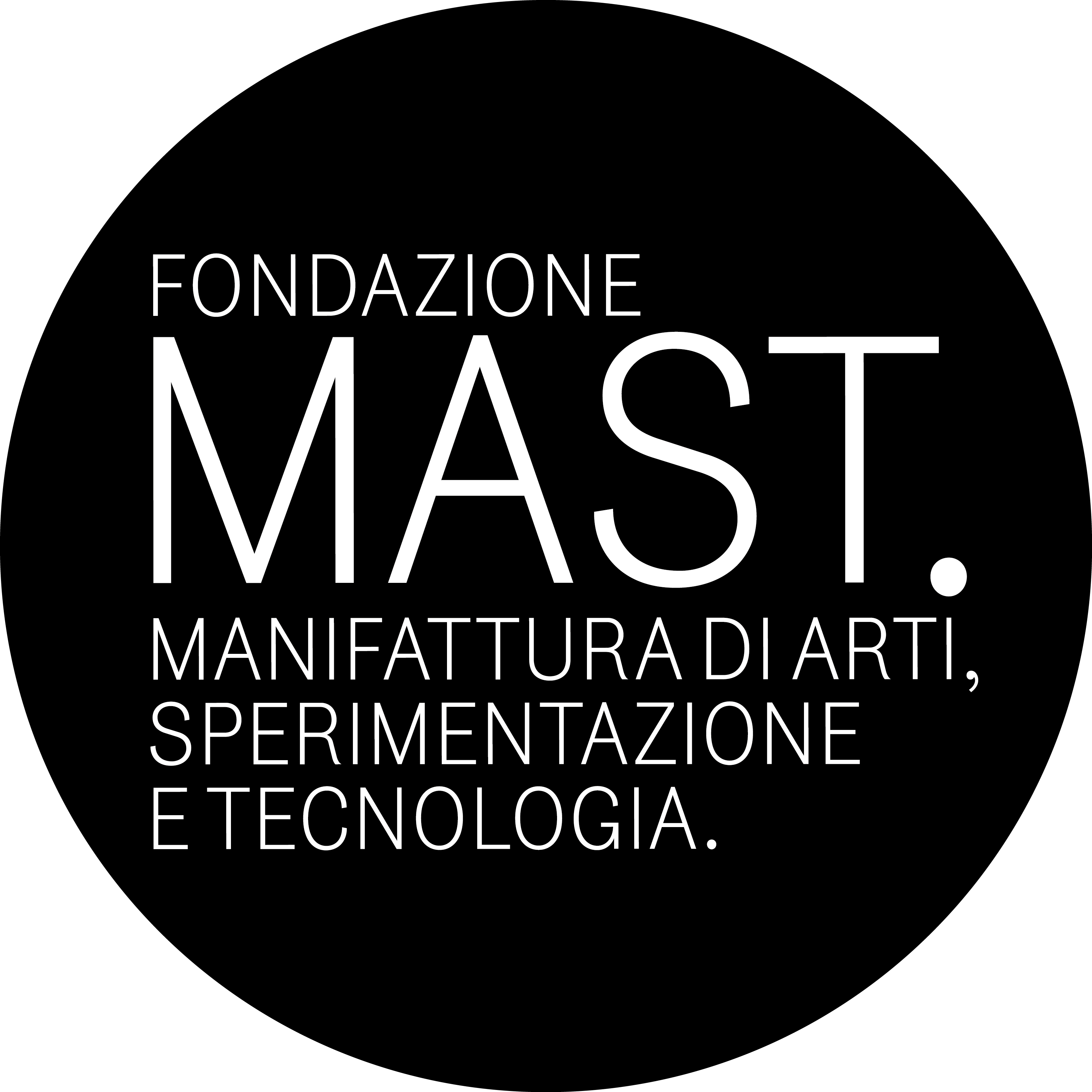Language
The MAST Collection of Photography on Industry and Labour is the first of its kind in the world, and is growing continually with new acquisitions, some of which were presented in the first show in 2014. The exhibit is divided into five thematic sections, and is curated, along with the exhibition space, by Urs Stahel:
1. WORK , WORKER: a portrait of the labourer and the image of the industrial landscape are presented as they change over the course of time, from the beginning of the twentieth century to present day.
2. INDUSTRIAL AREA, INDUSTRIAL PLANT: the theatre of industrial production is discussed through pairs of contrasting images: "The past and today."
3. LIGHT AND SHADE: the black, fiery, dark factory of the past, overflowing with workers and the white, sterile, bright and empty pavilions of today.
4. VISIBILITY/INVISIBILITY: the contrast between the early massive heavy machinery, and its visibly comprehensible processes, and the mute, enigmatic, aseptic modern production tools.
5. FLOW OF ENERGY, FLOW OF TRAFFIC, FLOW OF DATA: no industrial production process can do without energy, transport, handling of raw materials, semi-finished and finished goods, and now data and communication flows between man, machine and equipment.
With these five chapters, the MAST Foundation has begun to write a history of industry and labour with images by the major photographers who have documented their inception and evolution until now.
We live in the western world, in what is generally referred to as the post-industrial era. Many factories have been closed and production processes delocalized. Europe is changing face, turning itself into a great service providing continent.
The concept of post-industrial is only effective, however, if we relate it to the fact that, despite having moved many enterprises to Asia and delocalized production processes, we continue to derive profit from the economic results obtained. It is less fitting if we consider that the cardinal points are still those of an industrial type economy: inventiveness, investment, production.
In the past, society has often experienced a certain unease in its relationship with industry. It was clear right from the start, and continues to be so, that industry responds to our needs, brings enormous benefits, creates prosperity and makes our lives easier. But how do we talk about it? It is evident to everyone how pleasure in beautiful things is strongly embedded in our society. We talk about the beauty of the landscape, of works of art, fashion, beautiful people, beautiful cars. In contrast, we speak much less willingly when referring to production processes. It is as if a recurring image, evoked by the heavy industry of the past, still loomed over the entire sector of industrial production. So, if on the one hand we readily discuss extraordinary results and exceptional products, on the other we tend to overlook the difficulties production and producers encounter. And in some circumstances industry is alluded to as society's grey area. This can be seen in the controversial relationship with images of the industrial world.
For decades, photos of factories have been treated with total indifference and it was not uncommon for them to be thrown away when a company moved site. It is only recently that we have started to re-evaluate and retrieve them, thus realising we have eliminated the evidence of almost half of the world, the history, the universe of industrial production: a world that provides a valuable key to under stand our lives, our thought and our activities.


![{name=Seconda_immagine, data=1, type=text, options=[], Seconda_Immagine_Big={name=Seconda_Immagine_Big, data=/documents/41694/42046/11.-Margaret-Bourke-White.jpg/f8ac9b9a-395d-48d5-b27a-8ed2f3cc4610?t=1410535957988, type=document_library, options=[]}, Didascalia={name=Didascalia, data=, type=text, options=[]}}](/documents/41694/42046/11.-Margaret-Bourke-White.jpg/f8ac9b9a-395d-48d5-b27a-8ed2f3cc4610?t=1410535957988?width=300&height=200)
![{name=Seconda_immagine, data=2, type=text, options=[], Seconda_Immagine_Big={name=Seconda_Immagine_Big, data=/documents/41694/47735/10.-Walker-Evans.jpg/4a8d59d4-f57d-490c-82e6-85dafc4db7ab?t=1410535942949, type=document_library, options=[]}, Didascalia={name=Didascalia, data=, type=text, options=[]}}](/documents/41694/47735/10.-Walker-Evans.jpg/4a8d59d4-f57d-490c-82e6-85dafc4db7ab?t=1410535942949?width=300&height=200)
![{name=Seconda_immagine, data=3, type=text, options=[], Seconda_Immagine_Big={name=Seconda_Immagine_Big, data=/documents/41694/42046/9.2-Harry-Gruyaert-Brasil-Technip-Angra-Dos-Reis-2008.jpg/83921164-02b0-4e1f-afa3-22a98f9b793f?t=1410535916722, type=document_library, options=[]}, Didascalia={name=Didascalia, data=, type=text, options=[]}}](/documents/41694/42046/9.2-Harry-Gruyaert-Brasil-Technip-Angra-Dos-Reis-2008.jpg/83921164-02b0-4e1f-afa3-22a98f9b793f?t=1410535916722?width=300&height=200)
![{name=Seconda_immagine, data=4, type=text, options=[], Seconda_Immagine_Big={name=Seconda_Immagine_Big, data=/documents/41694/42046/9.1-Harry-Gruyaert-Belgium-Antwerpen.-Port-industry-1992.jpg/6dcb78bc-b317-443a-8da0-32fb1b3a4d00?t=1410535904038, type=document_library, options=[]}, Didascalia={name=Didascalia, data=, type=text, options=[]}}](/documents/41694/42046/9.1-Harry-Gruyaert-Belgium-Antwerpen.-Port-industry-1992.jpg/6dcb78bc-b317-443a-8da0-32fb1b3a4d00?t=1410535904038?width=300&height=200)
![{name=Seconda_immagine, data=5, type=text, options=[], Seconda_Immagine_Big={name=Seconda_Immagine_Big, data=/documents/41694/42046/7.3-Doisneau_Renault-Atelier-demboutissage-1935.jpg/f1d8bb22-3b1a-47e4-bd76-e92a1975ce20?t=1410535882885, type=document_library, options=[]}, Didascalia={name=Didascalia, data=, type=text, options=[]}}](/documents/41694/42046/7.3-Doisneau_Renault-Atelier-demboutissage-1935.jpg/f1d8bb22-3b1a-47e4-bd76-e92a1975ce20?t=1410535882885?width=300&height=200)
![{name=Seconda_immagine, data=6, type=text, options=[], Seconda_Immagine_Big={name=Seconda_Immagine_Big, data=/documents/41694/42046/7.2-Doisneau_Les-presses-de-Renault-1936.jpg/f046b427-1075-4c2a-bcb8-636d25265a0b?t=1410535868852, type=document_library, options=[]}, Didascalia={name=Didascalia, data=, type=text, options=[]}}](/documents/41694/42046/7.2-Doisneau_Les-presses-de-Renault-1936.jpg/f046b427-1075-4c2a-bcb8-636d25265a0b?t=1410535868852?width=300&height=200)
![{name=Seconda_immagine, data=7, type=text, options=[], Seconda_Immagine_Big={name=Seconda_Immagine_Big, data=/documents/41694/42046/7.1-Doisneau_Atelier-de-montage-des-moteurs-1938.jpg/3125e1f1-23c9-4357-892f-370eedc749ae?t=1410535852092, type=document_library, options=[]}, Didascalia={name=Didascalia, data=, type=text, options=[]}}](/documents/41694/42046/7.1-Doisneau_Atelier-de-montage-des-moteurs-1938.jpg/3125e1f1-23c9-4357-892f-370eedc749ae?t=1410535852092?width=300&height=200)
![{name=Seconda_immagine, data=8, type=text, options=[], Seconda_Immagine_Big={name=Seconda_Immagine_Big, data=/documents/41694/42046/6.3-Baltz_-Power-supply-National-Center-Meteo-Grenoble-France.jpg/430bcbbe-da1d-41d1-9cf8-d1f638afa50c?t=1410535839075, type=document_library, options=[]}, Didascalia={name=Didascalia, data=, type=text, options=[]}}](/documents/41694/42046/6.3-Baltz_-Power-supply-National-Center-Meteo-Grenoble-France.jpg/430bcbbe-da1d-41d1-9cf8-d1f638afa50c?t=1410535839075?width=300&height=200)
![{name=Seconda_immagine, data=9, type=text, options=[], Seconda_Immagine_Big={name=Seconda_Immagine_Big, data=/documents/41694/42046/6.2-Baltz_-Anechoic-chamber-France-Telecom-Laboratories-Lannion-France.jpg/c2668150-6025-4e7a-bbf3-9e09eff5ebde?t=1410535818783, type=document_library, options=[]}, Didascalia={name=Didascalia, data=, type=text, options=[]}}](/documents/41694/42046/6.2-Baltz_-Anechoic-chamber-France-Telecom-Laboratories-Lannion-France.jpg/c2668150-6025-4e7a-bbf3-9e09eff5ebde?t=1410535818783?width=300&height=200)
![{name=Seconda_immagine, data=10, type=text, options=[], Seconda_Immagine_Big={name=Seconda_Immagine_Big, data=/documents/41694/42046/6.1-Baltz_-Anechoic-chamber-2-France-Telecom-Laboratories-Lannion-France.jpg/0ab4a68a-bb23-441a-afc6-38e93749644b?t=1410535803615, type=document_library, options=[]}, Didascalia={name=Didascalia, data=, type=text, options=[]}}](/documents/41694/42046/6.1-Baltz_-Anechoic-chamber-2-France-Telecom-Laboratories-Lannion-France.jpg/0ab4a68a-bb23-441a-afc6-38e93749644b?t=1410535803615?width=300&height=200)
![{name=Seconda_immagine, data=5, type=text, options=[], Seconda_Immagine_Big={name=Seconda_Immagine_Big, data=/documents/41694/42046/5.-Vogel_Ru%CC%88hrgebiet-1965.jpg/c51b81db-df47-458e-9ae5-8cb716b47523?t=1410535788148, type=document_library, options=[]}, Didascalia={name=Didascalia, data=, type=text, options=[]}}](/documents/41694/42046/5.-Vogel_Ru%CC%88hrgebiet-1965.jpg/c51b81db-df47-458e-9ae5-8cb716b47523?t=1410535788148?width=300&height=200)
![{name=Seconda_immagine, data=6, type=text, options=[], Seconda_Immagine_Big={name=Seconda_Immagine_Big, data=/documents/41694/42046/4.-Schneiders_Schienenspinne.jpg/8df45711-9b15-474e-98f0-b2cfa3a2e235?t=1410535771395, type=document_library, options=[]}, Didascalia={name=Didascalia, data=, type=text, options=[]}}](/documents/41694/42046/4.-Schneiders_Schienenspinne.jpg/8df45711-9b15-474e-98f0-b2cfa3a2e235?t=1410535771395?width=300&height=200)
![{name=Seconda_immagine, data=3, type=text, options=[], Seconda_Immagine_Big={name=Seconda_Immagine_Big, data=/documents/41694/42046/3.-Menuez-_-Exercise-Break-at-Intel-Fab-11X.-Rio-Rancho-New-Mexico-1998.jpg/06ff214d-00eb-4a12-8dba-289c1ebc7590?t=1410535757239, type=document_library, options=[]}, Didascalia={name=Didascalia, data=, type=text, options=[]}}](/documents/41694/42046/3.-Menuez-_-Exercise-Break-at-Intel-Fab-11X.-Rio-Rancho-New-Mexico-1998.jpg/06ff214d-00eb-4a12-8dba-289c1ebc7590?t=1410535757239?width=300&height=200)
![{name=Seconda_immagine, data=2, type=text, options=[], Seconda_Immagine_Big={name=Seconda_Immagine_Big, data=/documents/41694/42046/2.-Hatakeyama-_-Maquettes_Light-12_20-1995.jpg/a3a8a2cc-c0a0-4be4-846a-65405f501ea4?t=1410535745911, type=document_library, options=[]}, Didascalia={name=Didascalia, data=, type=text, options=[]}}](/documents/41694/42046/2.-Hatakeyama-_-Maquettes_Light-12_20-1995.jpg/a3a8a2cc-c0a0-4be4-846a-65405f501ea4?t=1410535745911?width=300&height=200)
![{name=Seconda_immagine, data=1, type=text, options=[], Seconda_Immagine_Big={name=Seconda_Immagine_Big, data=/documents/41694/42046/1.-Couturier-_-Melting-Power-Alstom-2.jpg/5634f2c7-5260-436c-9106-9473b1212f4a?t=1410535738503, type=document_library, options=[]}, Didascalia={name=Didascalia, data=, type=text, options=[]}}](/documents/41694/42046/1.-Couturier-_-Melting-Power-Alstom-2.jpg/5634f2c7-5260-436c-9106-9473b1212f4a?t=1410535738503?width=300&height=200)